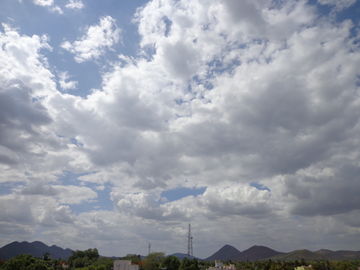Negative climate feedback

Negative climate feedback is any process where climate feedback decreases the severity of some initial change. Some initial change causes a secondary change that reduces the effect of the initial change. This feedback keeps the climate system stable.[2] It is generally discussed in the context of climate change and is one particular type of negative feedback. It is also important to remember that while "negative feedback" may not sound like a good thing, it actually helps the climate to remain much more stable than it would be without.
A human body cools itself through the evaporation of sweat, which cools the skin, reducing the need for sweat. This is a negative feedback. Some climate processes work the same way, a negative climate feedback decreases some initial change in the climate and push the climate back to its original state. For further explanation on what a negative feedback is in general, click here.
Although several types of negative feedback exist they are usually not distressing, unlike positive feedback. Generally, positive climate feedbacks cause undesirable side-effects as they accelerate climate change. With positive feedback, some minor change in the state of the climate can result in a large change overall. This is in stark contrast with negative feedback, which generally stabilizes some initial climate change by acting in the opposite direction, bringing it back to its initial state.[3] Negative feedbacks are important because small "mistakes" or "pushes" to the climate are accounted for and corrected without pushing the climate into an unstable state. Without negative feedbacks, the climate would be much more unstable in its behaviour.
Examples of Negative Feedback
There are several climate changes that can result in negative feedback. It is important to note that there are many different types of negative feedback that result in a different amount of comparative changes overall, so only a few are listed here
Evaporation and Clouds
Even when the surface temperature increases as a result of human activities, there can still be a negative feedback that results in some amount of cooling. For example, as the surface temperature of the Earth increases there are increased levels of evaporation from the oceans. This increased evaporation results in more clouds forming in the lower atmosphere. These clouds in turn reflect some incident solar radiation back into space, slightly decreasing the surface temperature.[4]
Blackbody Radiation
As well, the fact that the Earth is loosely modelled as a blackbody for climate models results in a negative feedback. As the temperature of the Earth increases, the Stefan-Boltzmann law states that the emission of infrared radiation back into space will increase. By increasing the amount of outgoing radiation as the Earth warms, there is a slight cooling effect. This type of feedback is also known as Planck feedback.[5]
References
- ↑ Wikimedia Commons. (October 10, 2015). Clouds in Vellore [Online]. Available: https://upload.wikimedia.org/wikipedia/commons/4/4e/Clouds_in_vellore.JPG
- ↑ NASA Global Climate Change. (October 10, 2015). The Study of Earth as an Integrated System [Online]. Available: http://climate.nasa.gov/nasa_role/science/
- ↑ NOAA. (October 10, 2015). Positive Feedback [Online]. Available: https://www.ncdc.noaa.gov/paleo/abrupt/story2.html
- ↑ Southwest Climate Change Network. (October 10, 2015). Negative Feedback Cycle [Online]. Available: http://www.southwestclimatechange.org/figures/feedback_cycles
- ↑ Zong-Liang Yang. (October 10, 2015). Chapter 2: The Global Energy Balance [Online]. Available: http://www.geo.utexas.edu/courses/387H/Lectures/chap2.pdf

